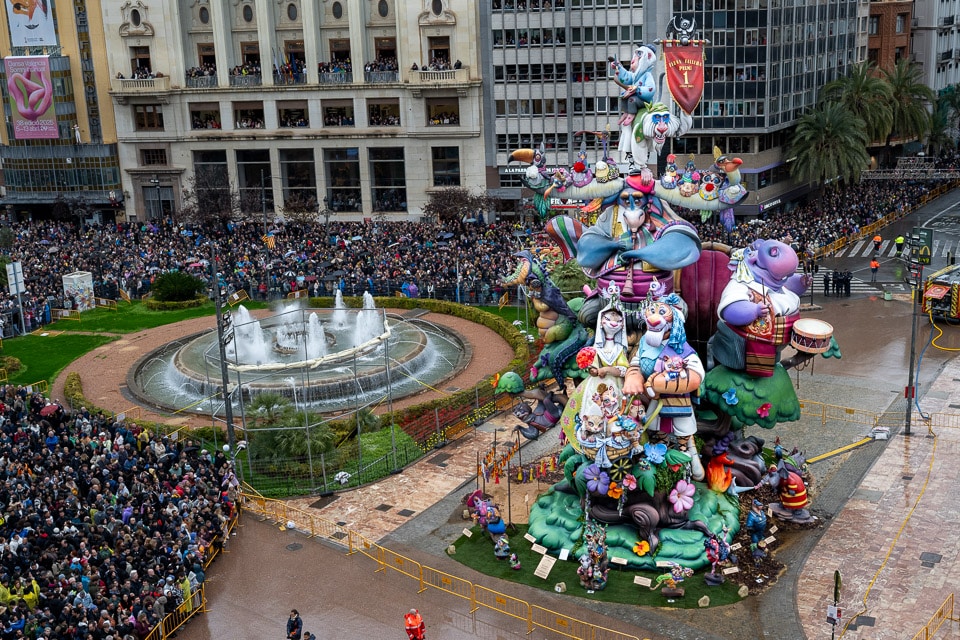
Every spring, the city of Valencia, Spain, literally explodes into a five-day spectacle of colorful sculpture, sound, and light known as the Las Fallas. Officially celebrated from March 15 to 19 every year, the Fallas (Falles in the Valencian language) are anticipated throughout the year by all Valencianos. The Fallas Festival is one of Spain’s most dramatic cultural events.
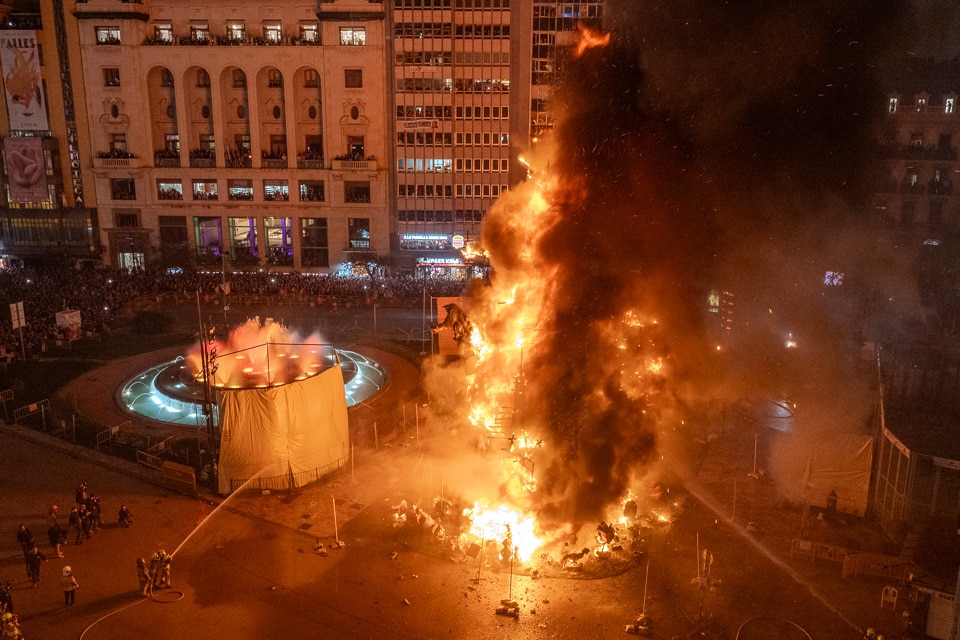
After attending the Fallas in 2025 and spending the five days of the celebration soaking in the almost 800 wonderfully detailed sculptures spread throughout the city's streets, the religious processions of the Ofrenda (flower offerings to the Virgin patroness saint of Valencia), and the smell of gunpowder from the constant pyrotechnic shows – both official and from random teenagers on every street – we can attest that this festival is certainly the most intense we've encountered in Spain, on many levels.
Table of Contents
The Origin of Las Fallas
Las Fallas trace back to the Middle Ages, when Valencia’s carpenters marked the arrival of spring and the feast day of Saint Joseph, the patron saint of carpenters, by burning wooden structures known as parots. These wooden devices, used to hold candles during the winter months, were not needed as the days grew longer. To dispose of them, the carpenters would gather the parots in the streets and set them ablaze in a symbolic act of renewal.
Over time, the fires grew more elaborate as people began to decorate the parots with old rags, clothing, and household items, eventually fashioning them into human-like figures. These figures evolved into colorful ninots (Valencian for “puppets” or “dolls”), first made of wood, then cardboard and papier mâché, and eventually with polystyrene and artistic painted finishes. The ninots are combined into huge structures and often crafted to satirize prominent citizens and politicians. What began as a springtime cleanup became a vehicle for social commentary, a community art project, and a public celebration rolled into one.
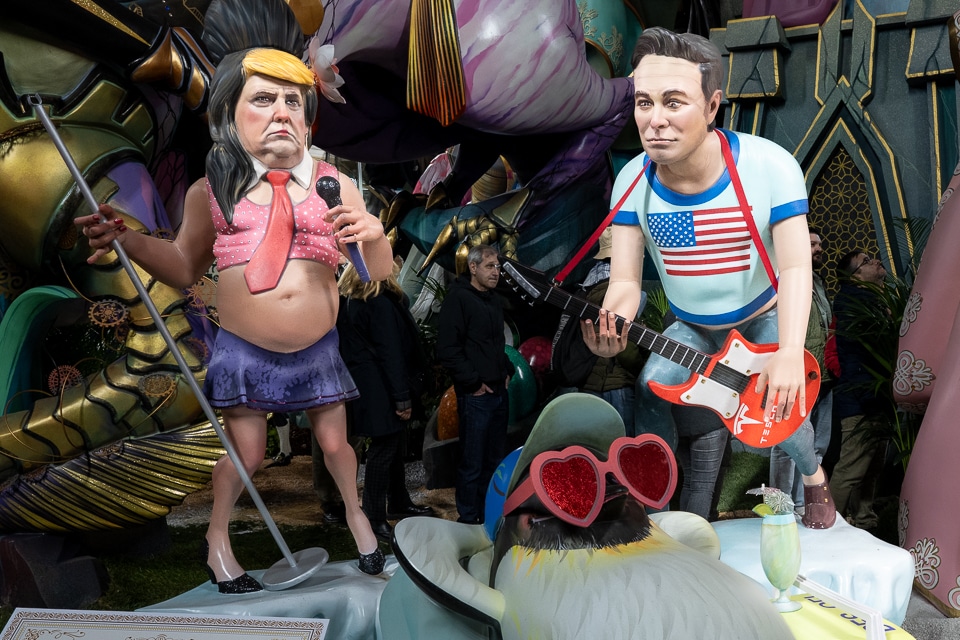
By the 18th and 19th centuries, the tradition had become deeply embedded in Valencian culture, and the ninots began to appear as monumental fallas, full-scale sculptural displays grouped around a central theme. These humorous, ironic, and frequently biting portrayals have become a hallmark of the festival.
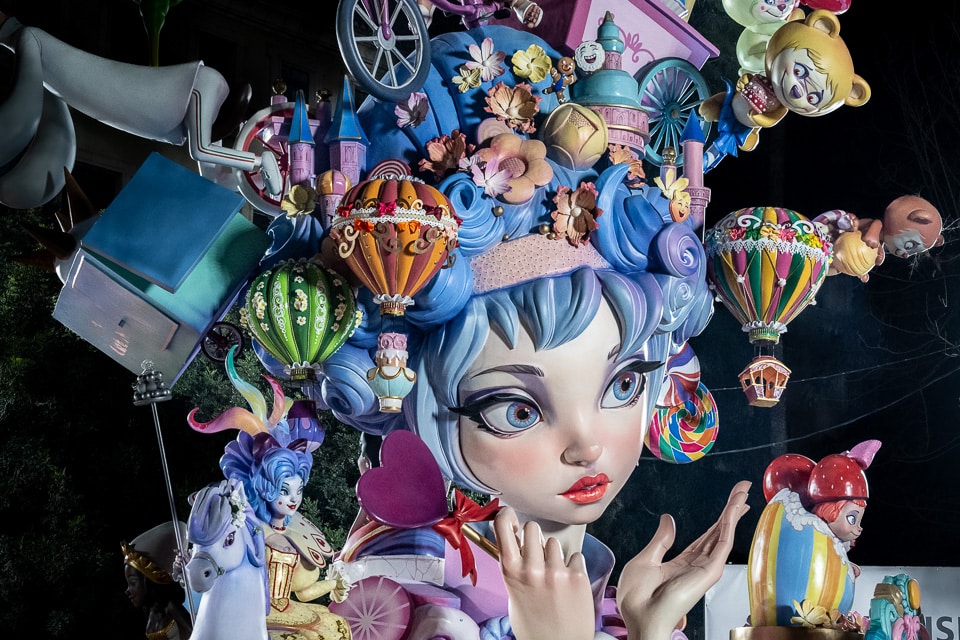
The Modern Fallas Festival
Today, the Fallas Festival is a UNESCO Intangible Cultural Heritage celebration, and draws hundreds of thousands of visitors from around Spain and the world. The festival represents an entire year of preparation but, perhaps ironically, culminates in an intense week filled with ritual burnings that destroy all the painstaking effort of the previous year.
Though not seen by the public during the festival, the loose federations that work on the monuments are rich and constant communities who work and socialize together, raise funds, plan their artistic statements and ultimately party together during the festival. These might be neighborhood groups, trade groups, business associations, or other organizations united in the efforts.
Around town, the fallas federations might set up a party tent for their own use during he festival, or work vendor carts to sell food and drinks to help recoup their falla expenses. Some neighborhoods host, for example, paella cooking competitions; others dance into the night, with babies and teens and elders – and everyone in between – sharing in the fun.
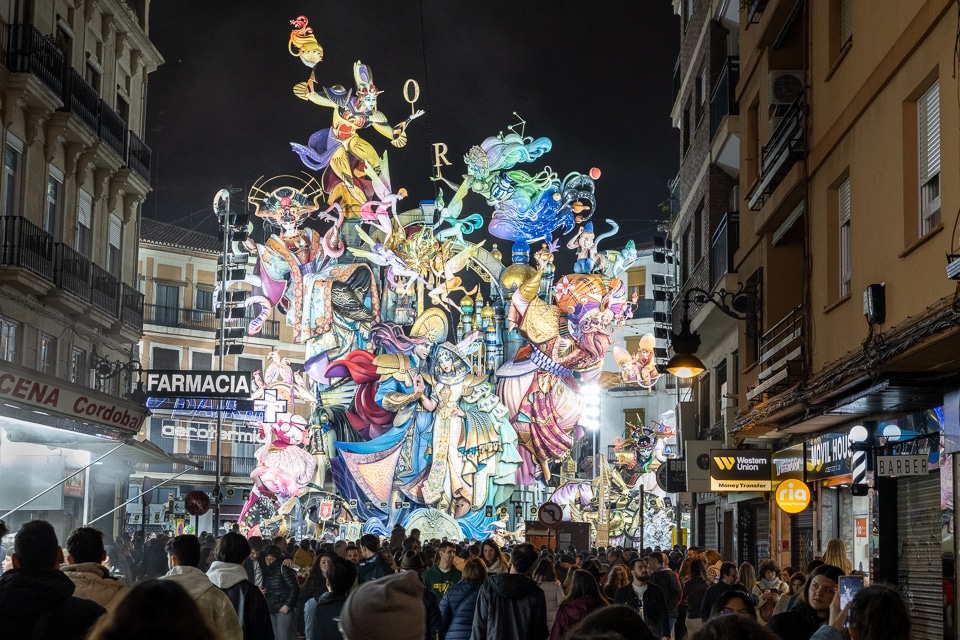
The Fallas Sculptures
At the heart of the celebration are the fallas themselves—elaborate, often multi-story sculptures made from wood, cardboard, papier-mâché, and polystyrene. These constructions are assembled by local neighborhood associations called casales falleros, who spend the entire year designing and fundraising for their creations. Some of the most elaborate fallas cost up to €250,000, which is the maximum expenditure allowed. Others, the effort of a smaller neighborhood casal faller may cost only a few hundred euros.
Each neighborhood competes for prizes in different categories. The most elaborate and expensive fallas may reach heights of 20 meters (65 feet) or more. Most fallas are composed of dozens of ninots arranged in fantastic and satirical scenes, poking fun at politicians, celebrities, cultural trends, or social issues.
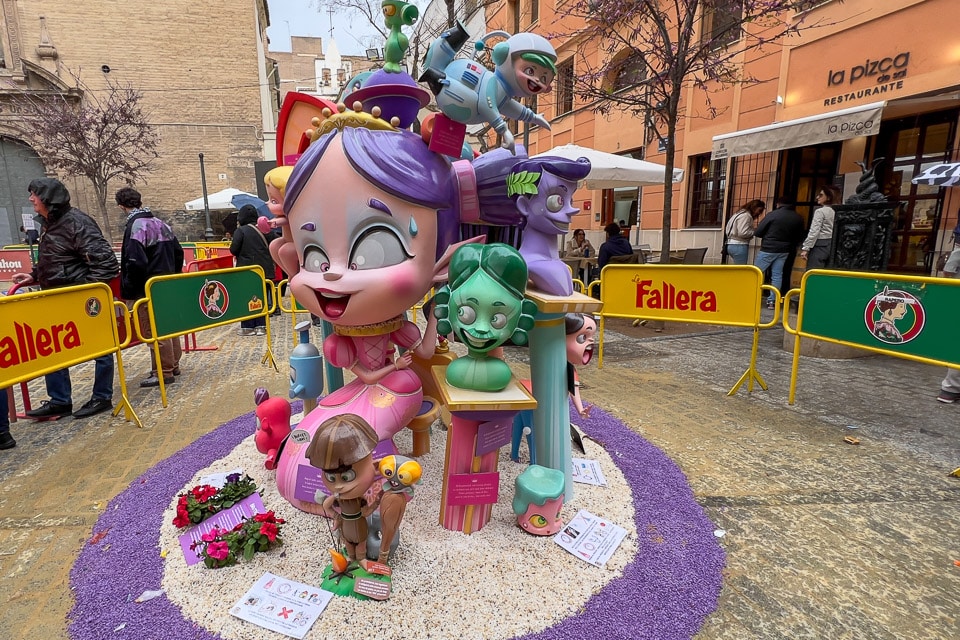
Each casal creates two types of fallas: a Falla Mayor – the large, central monument; and the Falla Infantil – a smaller, child-friendly version, usually more whimsical in theme.
In total, almost 800 fallas were installed throughout the city for the 2025 festival.
Key Events of the Fallas Festival
La Crida – The Opening Ceremony (End of February)
The Fallas Festival officially begins with La Crida, meaning “the call.” Held at the medieval Serranos Towers, this ceremony marks the city’s formal invitation to celebrate Fallas. The Fallera Mayor, a woman chosen each year to represent the festival, delivers a passionate speech to the city before a finale of fireworks and lights. As a cultural ambassador who represents the spirit of Fallas, she attends hundreds of events and is often seen in full traditional regalia. Portraits of each year's Fallera Mayor can be seen at the Museo Fallera.

The Mascletà – The Daily Fireworks Display (March 1 to 19)
Every day at 2 p.m. thousands gather for the Mascletà in the Plaza del Ayuntamiento (City Hall Square.) At precisely 2, there's a thunderous daytime fireworks show. Rather than a visual display, the mascletà is an orchestrated crescendo of rockets and gunpowder that rattles windows and shakes the ground. The display usually lasts only two to five minutes. Each day is hosted by a different pyrotechnic company, and spectators come to judge the rhythm, intensity, and impact of each display. You can expect kids in various neighborhoods will use this hour to set off pockets-full of their own incendiaries.
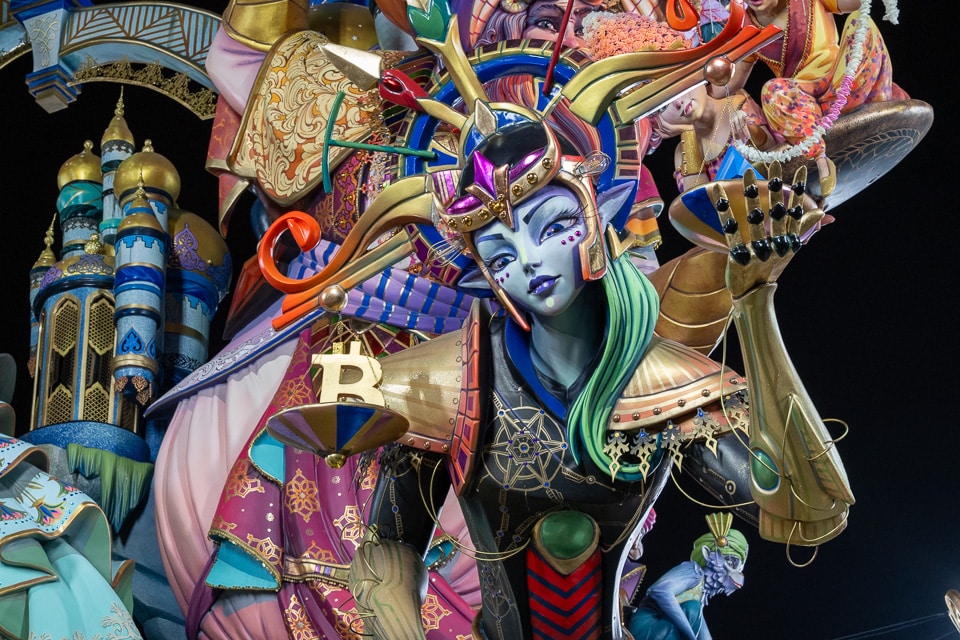
La Plantà – The Sculptures are Erected (March 15)
By the night of March 15, all fallas must be in place. This event, known as La Plantà, marks the installation of the fallas monuments throughout the city.
Judging of the fallas begins the next morning, and the best creations are awarded prizes by category.
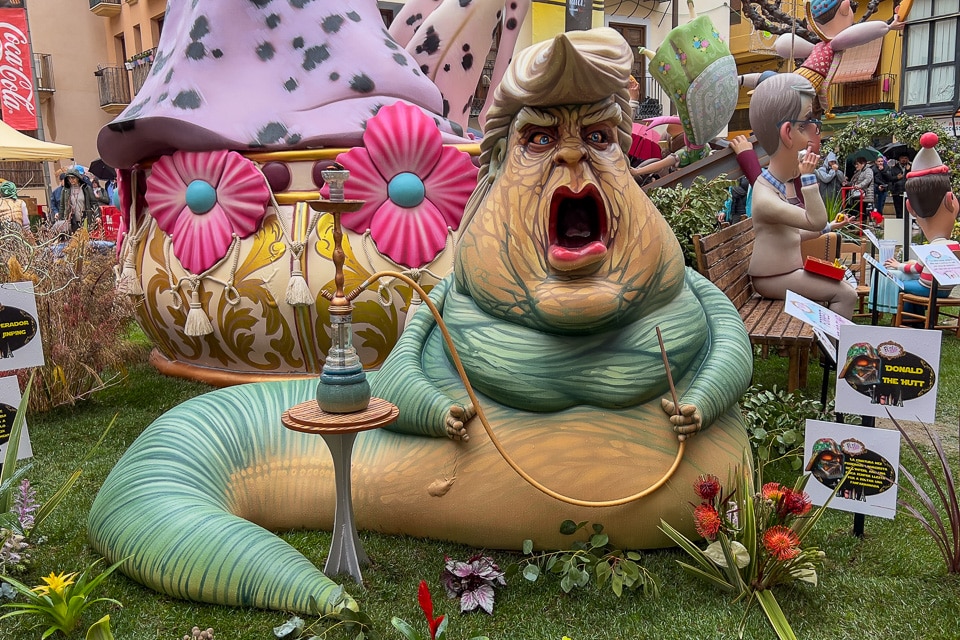
The Ninot Exhibition and La Indultà del Ninot
In the weeks leading up to Fallas, each casal fallero submits its best ninot to an official exhibition. Visitors vote on their favorites, and the winner of the popular vote is spared from the flames during La Cremà (the burning) and placed in the Fallas Museum—a rare honor known as the Ninot Indultat (the Pardoned Puppet.) Touring the Museo Fallero, we noticed the pardoned ninots were more likely to be realistic than fantastic, and more sentimental than satirical. They might display, for example, family or household scenes, grandparents with grandchildren, or long-suffering workers or mothers tending to their jobs.
This tradition allows the public to preserve one piece of Fallas artistry each year and creates a lasting archive of some of the most remarkable works.
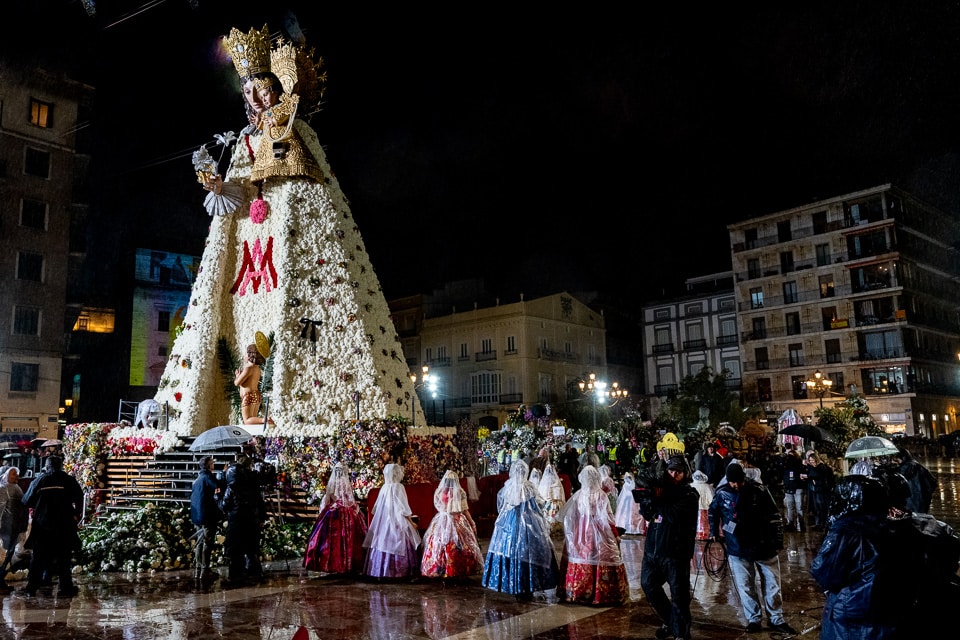
La Ofrenda de Flores – The Flower Offering (March 17–18)
Over two days, tens of thousands of falleras and falleros — men and women in stunning traditional Valencian dress — march through the streets to offer bouquets of flowers to the Virgen de los Desamparados – the Virgin Mary of the Forsaken, the patroness saint of Valencia. The flowers are arranged into an enormous tapestry on a towering wooden framework in Plaza de la Virgen and form the Virgin’s mantle.
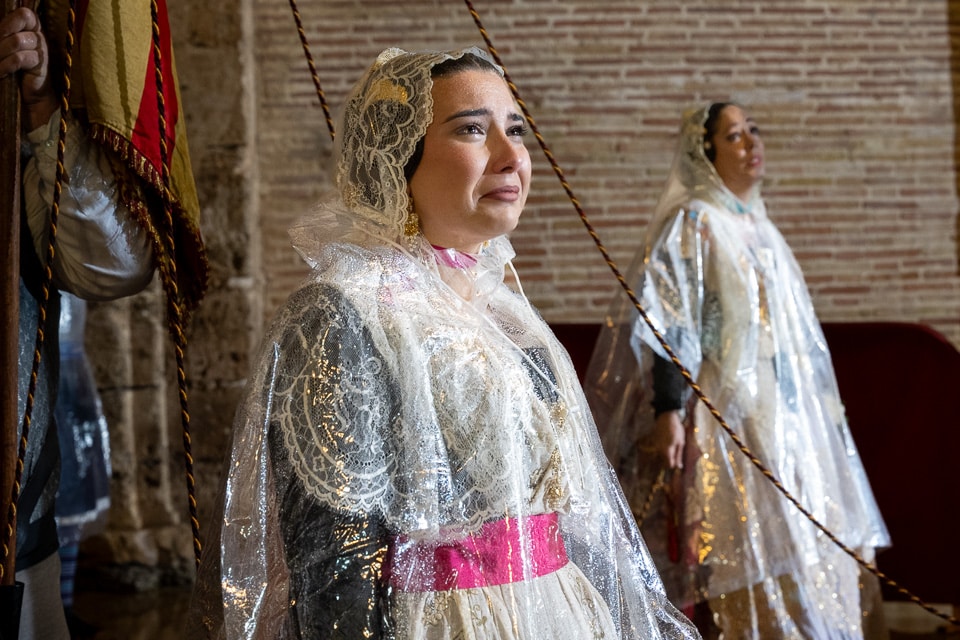
The offering is both a religious and cultural highlight of the festival, blending deep devotion with collective beauty. The atmosphere is quite emotional for many of the participants and it's not uncommon for some to break into tears as they enter the plaza in procession and get their first vision of the enormous flower covered image of the Virgin.
Nit del Foc – The Night of Fire (March 18)
On the eve of La Cremà is biggest fireworks show of the festival — the Nit del Foc or Night of Fire. In the early hours of March 19, the show draws huge crowds to the old riverbed park, now the Turia Gardens.
Firework displays are a constant throughout Fallas week, but the Nit del Foc is the ultimate spectacle and lasts up to 30 minutes with dramatic bursts that grow in intensity over the time.
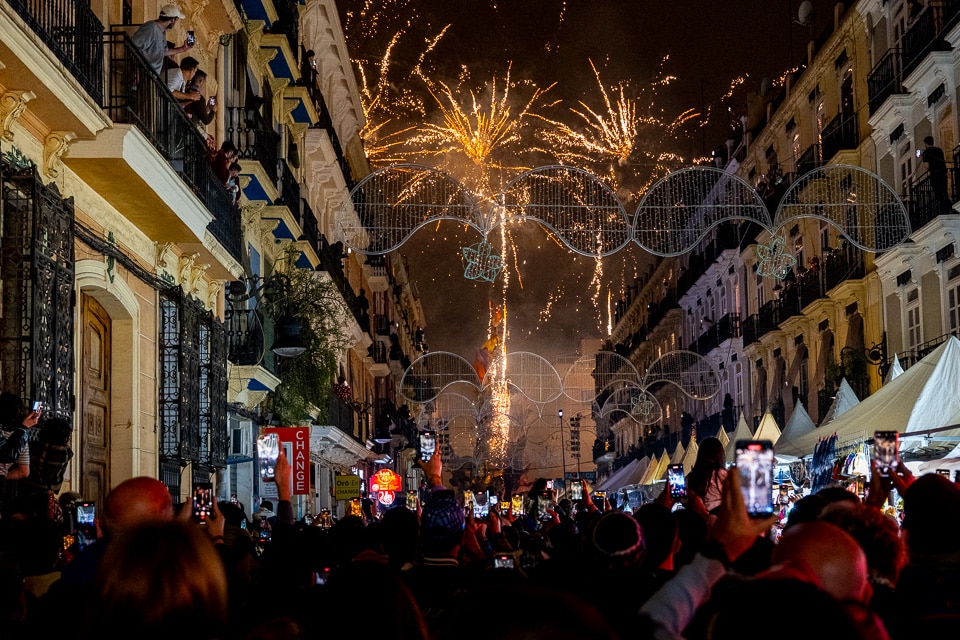
La Cremà – The Burning (March 19)
The festival ends in flames with La Cremà, the burning of all the fallas on the festival's last day. The children's fallas were burnt at 8 p.m. followed by the larger fallas at 10 p.m., the first place winner at 10:30. The last falla to burn is the city’s grand falla in Plaza del Ayuntamiento at 11:30. And every one of these burnings starts off with its own blast of rockets and fireworks, even within the narrow streets where many of the neighborhood fallas are located.
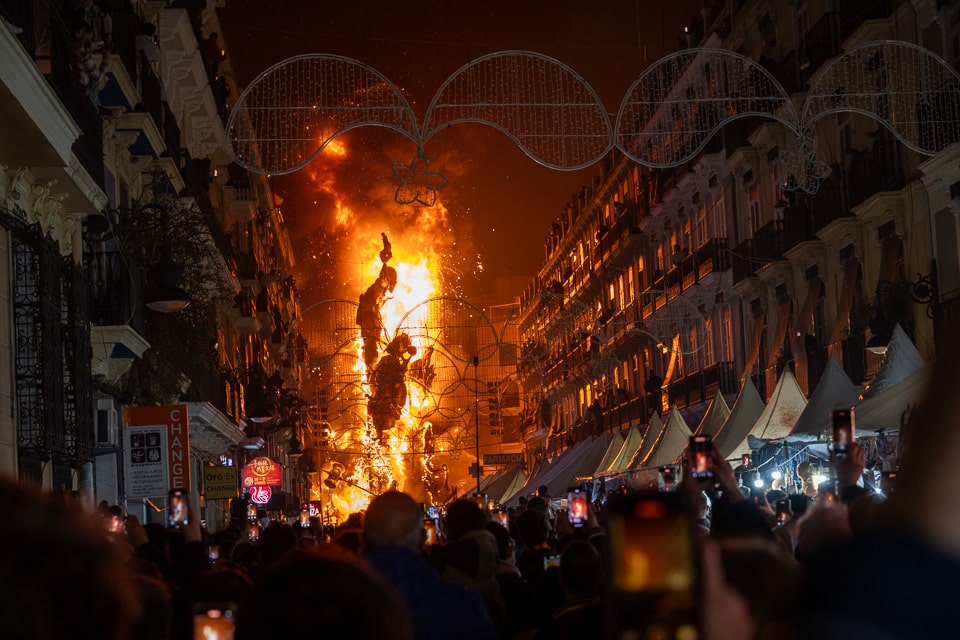
Food of the Fallas Festival
Naturally, food is a top priority during the festival. With so many people roaming the streets day and night, restaurants usually device a fixed menu for the duration, and reservations for midday meals are a great idea. This is when Valencia shares its love of their original paella rice dish, traditionally made with chicken, rabbit, flat green beans, large white beans, artichokes, and a few snails thrown in for flavor, with saffron as one of the magic ingredients.
Pastry shops are busy day and night, with customers lined up to enjoy the special buñuelos de calabaza, or pumpkin fritters dusted with sugar or dipped in chocolate. Churros are popular, too, served with chocolate. These sweets might be downed with cafe con leche, but are best with the very special local horchata, made from tigernuts which are native to the area. This delicious, milk-colored drink is served cold and offers a nod to the huerta, the rich agricultural area around Valencia.

What the Fallas mean
It's difficult to understand why so much effort is expended to create so many wonderful works of art just so they can be ritually destroyed every year. The best explanation I got is that the Fallas Festival, in its entirety, is deeply symbolic. The Fallas Festival embodies its spring equinox timing: renewal, letting go of the old, and starting fresh. The ritual can be profoundly cathartic and oddly mesmerizing as the spectacular monuments are consumed. The crowds sometimes cheer, but there are also plenty of spectators who appear stunned or even tearful.
It is a unique experience, to be sure.
Up Your Travel Skills
Looking to book your next trip? Use these resources that are tried and tested by us. First, to get our best travel tips, sign up for our email newsletter. Then, be sure to start your reading with our Resources Page where we highlight all the great travel companies and products that we trust. Travel Accessories: Check out our list of all the accessories we carry to make getting there and being there a lot easier. Credit Cards: See our detailed post on how to choose the right travel rewards credit card for you. Flights: Start finding the very best flight deals by subscribing to Thrifty Traveler. Book your Hotel: Find the best prices on hotels with Booking.com. See all of the gear and books we like in one place on our Amazon shop.Got a comment on this post? Join the conversation on Facebook, Instagram, or Threads and share your thoughts!



